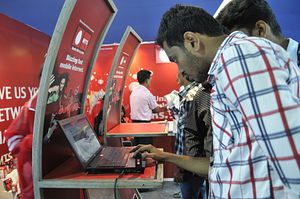Does it matter how many “likes” does your Facebook post gather when you are a powerful politician? Or how many followers do you have on Twitter? It does in India. Dozens of parliamentarians from the ruling Bharatiya Janata Party (BJP) have recently been chastised by their leadership for not being active enough on the Net. This is one of the many examples of the immense growth of the Internet market in India.
Not surprisingly, the world’s second most populous country is registering rapid growth in netizen numbers. Back in 2013 it was estimated that India had some 200 million Internet users, and that number was expected to double by the end of 2015. The rise of dot-com companies is a foregone conclusion. Mobile phone applications to call in cabs – from companies such as Uber and Ola – unheard of 10 years ago, are becoming part of ordinary life, despite certain initial problems. Projects that provide slum children with Internet access through hole-in-the-wall computers or that give farmers access to vital information such as market prices in nearby cities have been around for a while and may have served as positive game changers for at least some individuals. Indians and Pakistanis have also been found to be top users of marriage matching websites, although this data could well be inflated by those living outside their countries and may also be a curious example of blending tradition and modernity: The Internet is helpful to families trying to arrange a caste marriage when the marriage partner lives far away. And while Facebook’s Free Basics campaign failed in India despite a vigorous campaign, Google is busy providing Wi-Fi at selected railway stations. In these circumstances, it is hardly surprising that Indian politicians also took note of their electorate’s online life.
You know Internet is important for the people when leaders start to promise Wi-Fi. In 2014, Arvind Kejriwal of the Aam Aadmi Party promised free public access to the Internet to the citizens of Delhi. In January 2015, his party crushed its rivals in the Delhi Assembly elections. Hundreds of kilometers east of Kejriwal’s turf, the Chief Minister of Bihar, Nitish Kumar, has introduced wide access to the Net in Patna, the capital of Bihar. He then proceeded to win the elections in his state in the fall of 2015. The difference, however, is that Kejriwal first promised Wi-Fi and then won the elections (and he has yet to fulfill his promise) while Kumar first provided Wi-Fi and then won. By no means I am claiming that Wi-Fi has become the most important political issue or that it substantially weighed on the election result. But its appearance is election manifestoes is nonetheless noteworthy.
One of the leaders in the virtual race is Indian Prime Minister Narendra Modi. Even before he took power, Modi was reported to spend four hours daily reading e-mails. The tech-savvy and PR-driven politician also used the Internet to address various election rallies while appearing on 3D screens. As prime minister, Modi also went viral with a selfie he took with China’s Li Keqiang, a move promptly dubbed as “selfie diplomacy.” At the time of writing, Modi’s Facebook profile already has more than 33 million likes. As such, Modi is the world’s second most followed politician on Facebook after Barack Obama. The same is true on Twitter. But Facebook and Twitter are too obvious. Before his visit to China Modi had also started running an account on the Chinese social media website Weibo. While some Chinese netizens used his first post as an occasion to remind him that “Tibet is China,” somebody else asked “Where is the Weibo account of the Chinese Prime Minister?” This is a strange paradox: In a country where freedom of speech on the Net is severely limited, the head of government of a foreign country has joined Weibo more freely than many Chinese politicians would. And if you are a troubled Indian – for example a child in stress – the Indian prime minister is even promising to console you with his advice once you download the Narendra Modi app on your smartphone.
Even more interestingly, the ruling party leadership decided in April 2016 to survey its 280-odd Lok Sabha (lower house of Indian parliament) members regarding their Internet activities. The BJP wanted to check whether its representatives used their social media handles to popularize government undertakings, how often they interacted with Internet users, how many likes their Facebook posts received, and how many times their tweets were shared. While some were praised it was discovered that a number of politicians did not even have a Twitter account and those were presumably asked to change this. Soon every party’s line will be to be on-line.
The way Suresh Prabhu – the current Railway minister – is using his Twitter handle is far less virtual. He has become known for addressing grievances and calls for help through the microblog website. From a hurt child on a train to a search for a lost family member, the railway ministry has often responded to tweets by promptly pushing his relevant subordinates to solve the problem. The Internet has thus become not only a quicker (albeit informal) way of registering complains but also, due to its nature, a more visible one, and thus one that is especially important for politicians. Of course, this sort of rapid-fire reaction is obviously only possible for more personal issues. It would hardly work for calls to introduce bullet trains.
Although more than half of Indians still do not have regular access to the Internet, the virtual revolution promises to be a way for ordinary citizens to contact their leaders and push them to act for hundreds of millions. India has already seen the rise of the “no toilet, no wife” motto. Will “no Wi-Fi, no wife” be next? “No Wi-Fi, no politician” is certainly around the corner.

































